5 Best Base Towns for Exploring Provence Without a Car
If you’d like to explore Provence but don’t want to rent a car, you’re not alone. Driving in France isn’t for everyone: between the roundabouts, toll roads, and narrow village streets, it can be more stressful than scenic.
But you can still see a lot of what makes Provence magical if you pick the right home base. These five towns offer good public transport, walkable centers, and easy access to some of the region’s best sights – no car keys needed.
Note: this list focuses on towns that make it easy to explore the heart of Provence, places like the Luberon, the Alpilles, and southern Vaucluse. We prioritized walkable towns with solid east–west connections.
1. Avignon

Avignon is one of the easiest access points in Provence. It has two train stations, the central Gare d’Avignon-Centre and the TGV station just outside town, with fast connections from Paris, Lyon, and Marseille.
The TGV drops you off in under three hours from Paris. A quick local shuttle connects to the historic city center.
Inside the old walls, Avignon is compact and walkable. The medieval center is dense with history: the Palais des Papes, the Pont d’Avignon, and squares lined with cafés and shaded by plane trees.
Buses and regional trains from there can get you to Arles, Nîmes, Orange, and even the Pont du Gard.
If you’re staying for a few days, you can explore several nearby towns without needing a car at all. Local transit isn’t lightning-fast, but it’s reliable and gets you where you need to go.
For accommodations, options range from budget-friendly guesthouses inside the ramparts to mid-range hotels near the central train station. You can walk almost everywhere from the heart of the city.
2. Aix-en-Provence

Aix is a good choice for atmosphere, markets, and easy bus connections. The town has a polished feel – elegant architecture, wide boulevards, and daily open-air markets that spill through the old streets.
The historic center is fully walkable, and most hotels and rentals are within a short stroll of restaurants, shops, and bus stops.
The TGV station is about 15 minutes outside town by shuttle, but is well connected and easy to manage.
Local buses are a huge plus here. You can get to Marseille, Cassis, the Sainte-Victoire mountain, and even smaller villages like Le Tholonet without too much effort.
The bus station is central and well-organized, with routes clearly marked and timetables available in English.
While you won’t reach every Provençal hilltop village from Aix, you can cover a lot, especially if you don’t mind using the occasional tour or bike rental to fill in the gaps.
3. Arles
Arles is a quieter, less-polished base, but it’s incredibly rewarding, and well-connected by train. It takes around 20 minutes from Avignon, under an hour from Nîmes or Marseille.
Once you’re there, everything in the center is walkable. The Roman amphitheater, the Van Gogh spots, the Rhône-side cafés – you don’t need a car to enjoy them.
Regional trains connect Arles to Avignon, Nîmes, and Tarascon, with occasional service to Montpellier and other parts of Occitanie.
If you’re planning to explore the Camargue, there are local tours that leave from Arles and don’t require self-driving.
The train station is only a few minutes’ walk from the old town. Accommodations vary from simple 2-star hotels near the center to boutique stays tucked into quiet alleys.
4. L’Isle-sur-la-Sorgue
If you’re looking for a base that’s smaller and more picturesque, L’Isle-sur-la-Sorgue is famous for its canals and antique markets.
Even though it looks like a postcard, it’s a real community, with cafés, shops, and bakeries that serve locals as much as visitors.
You can reach it by train from Avignon in about 35 minutes. The station is a short walk from the center – though luggage can be a pain on market days when the town fills up.
Besides Avignon, L’Isle-sur-la-Sorgue is connected by train to Carpentras and Le Thor, and by bus to nearby spots like Cavaillon and Fontaine-de-Vaucluse.
Reaching hilltop villages like Gordes or Roussillon is possible but requires multiple transfers and careful planning.
If you’re staying there, be prepared to take things slowly. It’s not a transport hub, but it works well for travelers who want to base in a pretty town and plan a few well-timed day trips to bigger centers.
5. Marseille

Marseille might not be everyone’s first choice for a Provence trip, but it should be. It’s one of the best-connected cities in the south, and the local transit network is far better than many people expect.
From Marseille’s Saint-Charles station, you can catch trains to Arles, Aix-en-Provence, Cassis, Avignon, and even up to the Luberon.
The metro, buses, and trams make it easy to get around the city itself. And the ferry from the Old Port takes you to the Château d’If and Frioul Islands, no car needed.
It’s also the main jumping-off point for the Calanques, with boat tours and shuttle services that don’t require any driving.
Accommodations near the Vieux-Port give you easy access to transit, restaurants, and views.
Marseille is bigger and grittier than other towns on this list, but it rewards travelers who want access, variety, and some city buzz mixed in with the coastal light.
Other Alternatives?
Here’s why these other towns aren’t in the list:
Saint-Rémy-de-Provence: Gorgeous, but no train station. You’d be relying entirely on infrequent buses or pricey taxis.
Gordes / Roussillon / Moustiers-Sainte-Marie: Amazing for visits, but not realistic bases without a car. No rail access, and public transport is sparse.
Uzès: Beautiful, but transport options are limited and not well timed for day trips.
Orange: Has a train station, but fewer services and less appeal as a base than Avignon.
In Conclusion
You don’t necessarily need a car to see Provence, you just need a base town with the right connections. The above five options offer different experiences, and if you time your day trips smartly, you can cover a lot of ground without touching a steering wheel.
